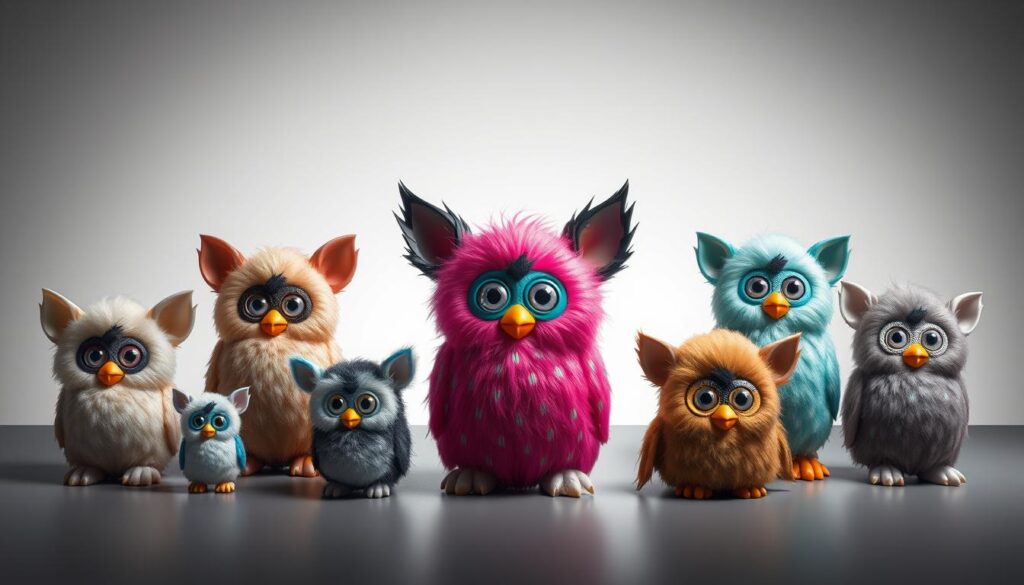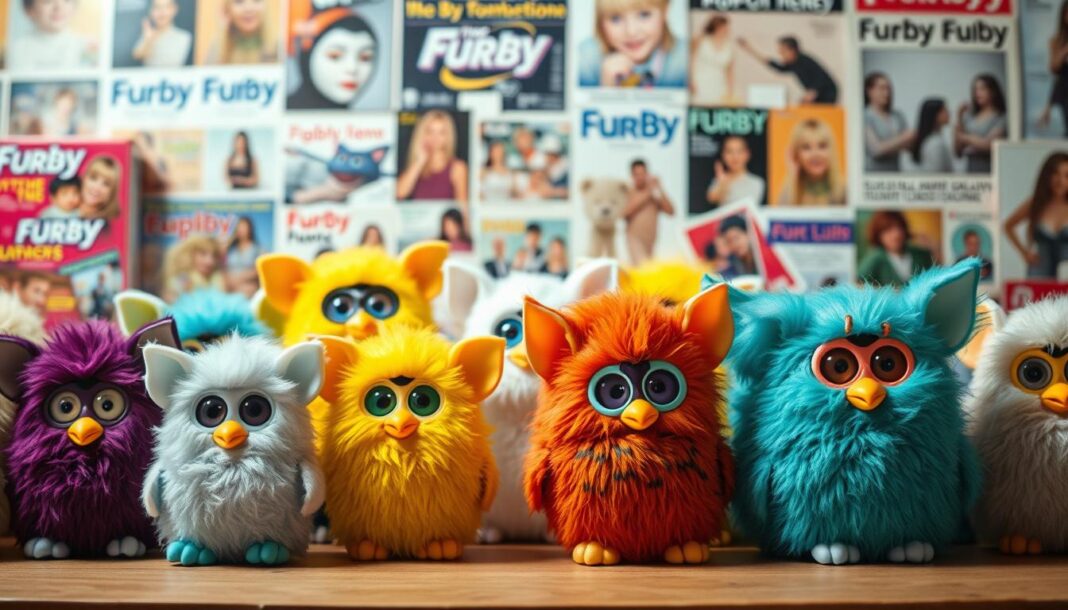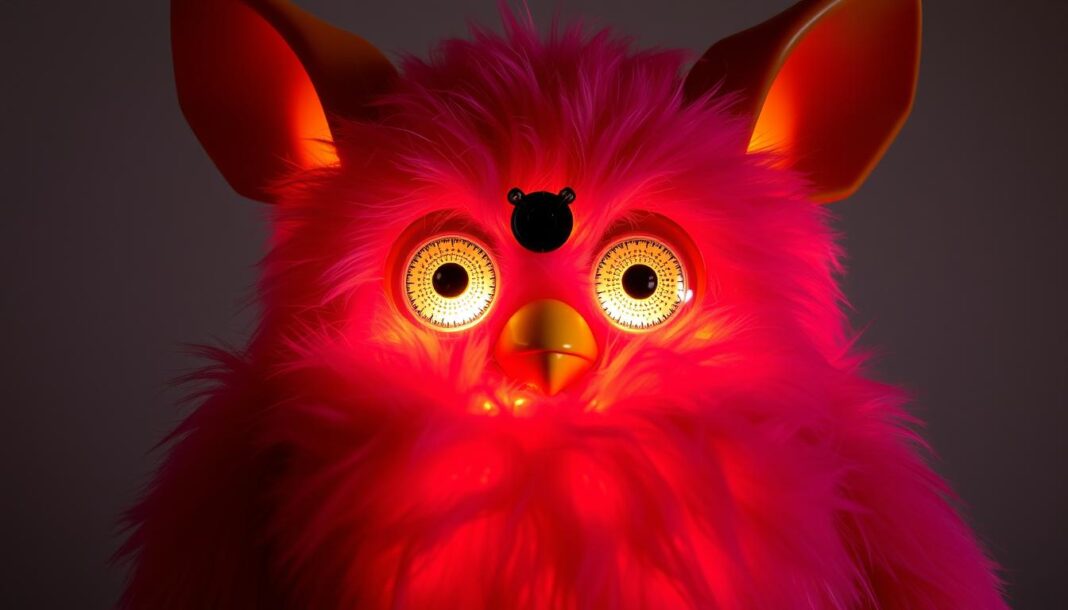Furbies are more than just toys; they’re a cultural phenomenon. These iconic robotic companions first hit the shelves in 1998, instantly capturing hearts worldwide. With their unique blend of fur, sensors, and pseudo-AI, they became a must-have for kids and collectors alike.
Over 58 million units have been sold, making Furbies one of the most successful toys in history. Their ability to interact, learn, and even “speak” their own language made them pioneers in interactive toy design. They didn’t just entertain—they changed the way we play.
From their original release to modern versions, Furbies have evolved with technology while maintaining their charm. Their legacy spans over 25 years, proving their lasting appeal. Dive into their fascinating journey and discover how they became a staple in toy history.
For those looking to own a piece of this legacy, check out our collection of authentic Furbies. Whether you’re reliving childhood memories or starting a new collection, these toys are a timeless treasure.
What Year Did Furbies Come Out? The Birth of a Pop Culture Icon
When Furbies debuted in 1998, they quickly became a holiday sensation. Introduced at the American International Toy Fair by Tiger Electronics, these robotic companions were unlike anything the world had seen. Their hamster-owl design, Furbish language, and light/tilt sensors made them an instant hit.
The original Furby retailed at $35, but demand skyrocketed during the holiday season. Parents camped outside stores, and resale prices soared to $100-$300. Production struggled to keep up, creating a lucrative secondary market. By the end of 1998, 1.8 million units had been sold, with 14 million more flying off shelves in 1999.
Furbies weren’t just toys—they were a cultural phenomenon. Their ability to “learn” English and interact with users made them pioneers in interactive play. Even urban legends emerged, like the rumor that the NSA banned them over espionage fears. To learn more about their fascinating journey, check out our guide on the original Furby.
The 1998 Launch: A Holiday Sensation
The 1998 holiday season was a whirlwind for Tiger Electronics. Furbies became the must-have gift, with stores selling out within hours. eBay auctions saw prices triple, and parents went to great lengths to secure one for their kids. The frenzy was a testament to the toy’s innovative design and appeal.
Initial Sales and Hype
In their first year, Furbies sold 27 million units worldwide. The United States led the charge, with families embracing the toy’s unique charm. Despite production challenges, Tiger Electronics worked tirelessly to meet demand, ensuring Furbies remained a holiday staple through 1999.
The Inventors Behind Furbies: Dave Hampton and Caleb Chung
Behind every iconic toy lies a story of innovation and creativity. For Furbies, that story begins with Dave Hampton and Caleb Chung. These two inventors combined their unique skills to create a toy that would become a global sensation.
Dave Hampton, a Navy veteran, drew inspiration from his experiences with Asian languages. Caleb Chung envisioned a child’s first friend, a toy with emotional resonance. Together, they spent 18 months perfecting their idea—9 months on prototyping and 9 on design.
From Concept to Creation
The journey from concept to creation was filled with challenges. Voice synthesis, motorized movements, and IR communication were just a few of the technical hurdles. The original code was written in 6502 assembly language, a testament to the time and effort invested.
Despite the limitations of an 80KB ROM, the duo crafted a model that could interact, learn, and even “speak” its own language. Their vision was clear: to create a toy that felt alive.
The Role of Tiger Electronics
Bringing Furbies to the masses required a partner with expertise in production. Enter Tiger Electronics. With the help of Richard C. Levy, the inventors secured a partnership that transformed their prototype into a mass-produced toy.
Tiger Electronics streamlined the process, ensuring Furbies were ready for the holiday season. Their collaboration turned a dream into reality, making Furbies a household name in just a few years.
The legacy of Dave Hampton and Caleb Chung lives on, not just in Furbies but in their subsequent projects, like the Pleo robot dinosaur. Their work continues to inspire innovation in the world of interactive toys.
The Evolution of Furbies: From 1998 to Today
From their humble beginnings, Furbies have grown into sophisticated interactive devices. Over the years, they’ve evolved with technology, offering new features and personalities that keep them relevant. Let’s explore their journey through the decades.

First Generation: The Classic Furby
The original Furby, released in 1998, was a marvel of its time. With mechanical movements and a 6502 microprocessor, it could interact and “learn” English. Its design was simple yet captivating, making it an instant hit.
Parents and kids alike were drawn to its unique charm. The classic Furby set the stage for future innovations, proving that interactive toys could be both fun and educational.
Emoto-Tronic Furbies: A Technological Leap
In 2005, the Emoto-Tronic Furby introduced voice recognition and emotional expressions. This model used servo-powered mechanisms to convey feelings, making it more lifelike than ever before.
This technological leap allowed Furbies to respond to voices and touch, creating a deeper bond with their owners. The Emoto-Tronic Furby was a game-changer in the world of interactive toys.
Modern Furbies: Apps and Personalities
The 2012 models brought LCD eyes and app integration, allowing users to customize their Furby’s personalities. These new Furby versions could connect to iOS and Android devices, offering a range of interactive features.
However, the 2023 model took a different approach. It removed app connectivity but added glowing ears and over 600 responses. This back-to-basics design focused on voice activation, making it more intuitive and user-friendly.
| Generation | Key Features | Year |
|---|---|---|
| First Generation | Mechanical movements, 6502 microprocessor | 1998 |
| Emoto-Tronic | Voice recognition, emotional expressions | 2005 |
| Modern | LCD eyes, app integration, glowing ears | 2012-2023 |
Through five distinct generations, Furbies have continued to innovate. From 24 Baby Furby colors to neon Furby Boom models, they’ve offered something for everyone. Collectors still seek rare editions like the Kid Cuisine and Jester Furbies.
For a deeper dive into their fascinating journey, check out our comprehensive guide. Whether you’re a longtime fan or new to the world of Furbies, their story is one of constant evolution and enduring appeal.
Furbies and Technology: How They Work
The technology behind Furbies is as fascinating as their charm. These iconic toys combine advanced features like voice recognition, sensors, and a unique language to create an interactive experience. Let’s dive into how they work and why they’ve remained a favorite for decades.
Furbish Language and Learning
Every Furby starts by speaking 100% Furbish, a playful mix of sounds and phrases. Over time, they begin to mix in English, creating a fun learning experience. For example, “wee-tah-kah-loo-loo” means “tell a joke.” This gradual transition mimics how children learn languages, making Furbies both entertaining and educational.
Voice Recognition and Sensors
Furbies use voice recognition to respond to their owners. The TSP50C04 chip handles linear predictive coding, giving them their signature robotic voice. Combined with tilt and tickle sensors, they can react to touch and movement. Modern models, like the Furby Galaxy Edition, take this further with over 600 phrases and enhanced motion detection.
Security Concerns and Myths
Despite their playful nature, Furbies have faced security concerns. In 1999, rumors spread that the NSA banned them over fears of audio recording. In reality, they lack recording capabilities. However, 2017 models had Bluetooth vulnerabilities, allowing hackers to inject audio. These incidents highlight the challenges of blending technology with toys in our connected world.
Furbies in Pop Culture: From Toys to Icons
Furbies have transcended their toy status to become cultural icons. Their unique blend of personality and interactivity has made them a favorite among fans of all ages. From movies to music, they’ve left an indelible mark on pop culture.
Furbies in Movies and TV Shows
Furbies have made memorable appearances in popular media. They’ve been featured in shows like The Simpsons and movies such as Uncut Gems and Mitchells vs Machines. These appearances have solidified their place in entertainment history.
Even McDonald’s got in on the action with their 2000 Happy Meal Shelby spinoff. Though a live-action movie by the Weinstein Company never saw the light of day, the idea itself shows how deeply Furbies have influenced storytelling.
Collector Craze and Cultural Impact
The collector community has embraced Furbies with open arms. Rare edition models, like the Crystal and Star Wars Furbacca, are highly prized. These unique designs have turned Furbies into valuable collectibles.
Platforms like TikTok have sparked a revival, with Gen Z customizing Furbies in creative ways. From songs to dance routines, these toys continue to inspire. Designer collaborations, such as Swarovski-bedazzled models, have further elevated their appeal.
Adult fans have formed communities to share their love for Furbies. These groups celebrate the toy’s history and showcase custom designs. The psychology behind this collector craze is fascinating, as people find joy in owning a piece of nostalgia.
| Collectible Edition | Unique Feature | Year Released |
|---|---|---|
| Crystal Furby | Transparent design | 1999 |
| Furbacca | Star Wars theme | 2017 |
| Swarovski Furby | Bedazzled fur | 2021 |
From their humble beginnings to their current status as cultural icons, Furbies have captured the hearts of people worldwide. Whether you’re a longtime fan or new to the craze, their journey is one worth exploring. For more on their fascinating history, check out our guide to Furbies.
The Legacy of Furbies: A Toy That Changed the Game
Few toys have shaped playtime like these interactive companions. The original 1998 model wasn’t just a toy—it was a child’s first robotic friend, blending tech with emotional connection. Over 25 years, they’ve inspired successors like Hatchimals and Tamagotchi Pix.
Their impact reaches beyond play. AI researchers cite Furbies in studies about anthropomorphism. Even today, original units still function, proving their durability. Modern versions boast features like expressive LCD eyes and app connectivity.
What’s next? Imagine AI-powered personalities or VR playdates. Whether you’re reliving nostalgia or discovering them anew, Furbies remain a timeless treasure. Explore their story further in our deep dive into their enduring magic.


